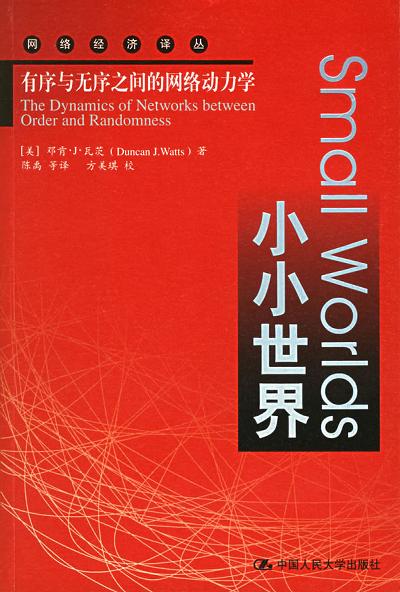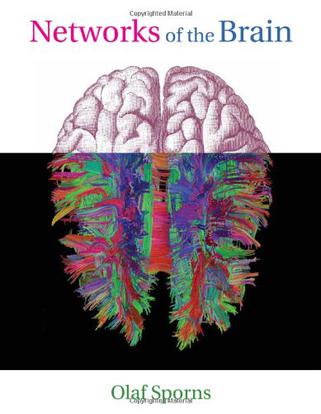-

社会网分析讲义
《社会网分析讲义(第2版)》:社会网分析的理论架构 社会网分析在社会学研究中的角色 社会网研究的类别 自我中心社会网资料的收集 整体社会网资料的收集 图形理论与社会计量学 中心性分析 小团体分析 社会资本的定义与衡量 角色分析 网络动态学 -

社会网分析讲义
《社会网分析讲义》编辑推荐:社会网分析是社会网理论在建立模型与实证研究时,收集定量资料与测量社会网变量必需的工具。 -

Scale-Free Networks
A variety of different social, natural and technological systems can be described by the same mathematical framework. This holds from the Internet to food webs and to boards of company directors. In all these situations a graph of the elements of the system and their interconnections displays a universal feature. There are only few elements with many connections, and many elements with few connections. This book presents the experimental evidence of these "Scale-free networks" and provides students and researchers with a corpus of theoretical results and algorithms to analyse and understand these features. The content of this book and the exposition makes it a clear textbook for beginners, and a reference book for the experts. -

六度分隔
正如副标题所表明的,《六度分隔:一个相互连接的时代的科学》的基本内容是介绍一门正在形成中的新科学——关于网络的一般规律的科学。有这样一门科学吗?它的内容和方法是什么?近年来,这门学科有什么实质性的进展吗?在《六度分隔:一个相互连接的时代的科学》中,作者根据自己的亲身经历娓娓道来,用讲故事的方式,对于这些问题给出了令人信服的回答 除了简要的背景和总结以外,《六度分隔:一个相互连接的时代的科学》可以分成两大部分前半部分讲述了学科产生的背景和主要的理论模型其中特别值得注意的是,第3章介绍的是小世界网络模型,第4章介绍无标度网络模型,第五章则介绍了关于搜索的模型这三章的介绍包括了这些模型的内容和意义这三章具有较强的理论性后半部分则广泛地介绍了在若干应用领域的应用状况。第6章讨论了疾病和计算机病毒的传播中的问题第7、8章研究了另外一些社会现象,例如,文化时尚、政治动乱,金融泡沫等告诉了我们什么。第9章则讨论了组织的坚固性和它对现代公司企业的启示。最后第10章对全书进行总结,提出一个简要的概括 对于具有高中以上文化基础的社会大众来说,可以通过阅读《六度分隔:一个相互连接的时代的科学》概括性地了解关于网络新科学的概况与最新进展而对于有兴趣深入了解现代系统科学,以及正在形成中的一般网络科学的读者,《六度分隔:一个相互连接的时代的科学》则是一个很好的入口和索引。 -

小小世界
《小小世界》内容简介:每个人都熟悉所谓“小世界现象”:当你遇见一个陌生人交谈不久之后,往往会惊奇地发现:“原来我们有共同的朋友!”或者说,仅通过几个熟识的人,我们就早已经相互联系在一起了,在这《小小世界》(有序与无序之间的网络动力学)中,邓肯·瓦茨(Duncan watts)将这种有趣的现象——俗称“六度分离” (six degrees of separation)——作为研究更一般现象的引子即证明了:在某种特定的条件下,小世界现象会出现在任何一种类型的网络之中。能够作为这一研究素材的网络无所不在:大脑是一个神经网络;社会上的组织是人际网络;全球的经济是国民经济组成的网络,国民经济又是市场组成的网络,而市场则是相互作用的生产者和消费者组成的网络。食物链、生态系统以及因特网也都表现出网络特征。此外,解决某一问题的策略,一次谈话中的主题,甚至一种语言中的词汇都能够形成某种意义上的网络。作者断言,这些网络都将归为“小世界网络”。这类网络是如何作用的呢?简单地说,是局部行为导致了全局性的结果,而局部动态特性和全局动态特性之间的关系,则主要依赖于网络的结构,瓦茨利用多种简单的模型阐明了这一关系的微妙之处,这些模型包括:人群中传染病的传播;博弈论中合作的演化;元胞自动机(即Cellutar Automata,CA)的计算能力以及耦合相位振子的同步等等。 -

Networks of the Brain
Over the last decade, the study of complex networks has expanded across diverse scientific fields. Increasingly, science is concerned with the structure, behavior, and evolution of complex systems ranging from cells to ecosystems. Modern network approaches are beginning to reveal fundamental principles of brain architecture and function, and in Networks of the Brain, Olaf Sporns describes how the integrative nature of brain function can be illuminated from a complex network perspective. Highlighting the many emerging points of contact between neuroscience and network science, the book serves to introduce network theory to neuroscientists and neuroscience to those working on theoretical network models. Brain networks span the microscale of individual cells and synapses and the macroscale of cognitive systems and embodied cognition. Sporns emphasizes how networks connect levels of organization in the brain and how they link structure to function. In order to keep the book accessible and focused on the relevance to neuroscience of network approaches, he offers an informal and nonmathematical treatment of the subject. After describing the basic concepts of network theory and the fundamentals of brain connectivity, Sporns discusses how network approaches can reveal principles of brain architecture. He describes new links between network anatomy and function and investigates how networks shape complex brain dynamics and enable adaptive neural computation. The book documents the rapid pace of discovery and innovation while tracing the historical roots of the field. The study of brain connectivity has already opened new avenues of study in neuroscience. Networks of the Brain offers a synthesis of the sciences of complex networks and the brain that will be an essential foundation for future research.